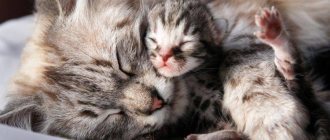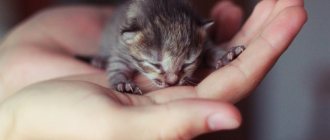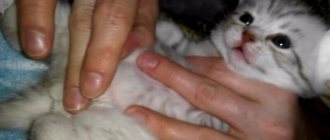In modern life, cats are the most common animals in our homes. And recently, more and more often, cats are bought not to hunt rats and mice, but to make a new friend or even a family member.
By bringing an animal into the home, a person is responsible for its life and health and undertakes to satisfy its needs. But sometimes there are situations when there is an adult cat in the house that has recently acquired offspring.
Several helpless lumps appear - two, three, five. All care for them falls on the shoulders of the owner. In this article we will look at how kittens are born, when their eyes and ear canals open, their first teeth appear, and we will analyze the changes that occur from birth until the moment the babies become independent.
Educational video about newborn kittens.
At what age does this happen?
The most important event for a cat's baby is the opening of its eyes. The process begins at approximately 2 weeks of life and lasts about 7 days. At first, babies slightly open their slits - their eyes, which become wider every day.
For the first 7 days, newborns do not see or hear anything around. At the beginning of life, it is necessary for them to be in a dark room; bright light negatively affects the development of the visual organs. After opening, the eyes are cloudy, with motionless pupils, until they begin to respond to stimuli and transmit signals from the optic nerves to the brain. After 2-3 days, the pupil becomes mobile, and the membrane of the eyes becomes transparent. After the eyelids open, kittens begin to move more and pay attention to objects that are interesting to them.
Kittens in the first week of life
Newborn kitties in the first week of their life are absolutely helpless: they cannot see (at birth their eyes are closed), hear (because the ear canals are blocked) and cannot even walk. They crawl slowly and chaotically in search of their mother's nipple. For the first 20 days of life, kittens need exclusively maternal care and warmth, since their body temperature is much lower than that of adults and thermoregulation is still poorly developed.
With the birth of offspring, cat owners often build a place where the new mother spends all her time with the babies, so that they do not crawl away or no one accidentally steps on them. This could be a large cardboard box with bedding. The only thing the owner can do to help the cat during this period is to keep the box clean, because if the cat finds the bed dirty, it will take its children to a more favorable place.
Why are kittens born blind?
Cubs are born blind, which is provided by nature to preserve their eyes. In addition, there are several reasons for this phenomenon:
- The babies' eyes are closed to protect them from infections, which often enter the mother cat's body and can be transmitted to offspring.
- The animal's amniotic fluid, in which the kitten swims, is also far from clean. Since immunity in fetal development has not yet been formed, this helps to avoid diseases of the organs of vision.
- Since a cat’s pregnancy proceeds very quickly, the development of the visual organs does not have time to fully occur in the mother’s body and continues after birth.
Features of newborn kittens
Tiny animals are born deaf, blind, with barely noticeable signs of life. This is completely normal and don’t be alarmed if the “lump” doesn’t react to you in any way.
Development will occur gradually, and humans should not interfere with this natural process.
A cat, even if this is her first birth, is endowed with all the instincts to raise her offspring. The babies will begin to hear and open their eyes soon enough, you need to be patient and wait.
© shutterstock
What determines the timing of eye opening in kittens?
The time it takes for babies to open their eyes is influenced by many factors.
Breed
It is genetically determined that in kittens of different breeds, the opening of the eyes takes a different period of time:
- Newborn Ragdolls are characterized by extremely slow development of their visual organs - pets begin to see in the 3rd week of life and later.
- Maine Coons begin to see sight 14-16 days after birth.
- Cubs of Siberian breed pets open their eyes at 12-17 days, just like British ones.
- Small Cornish Rex can see at 5-7 days.
- Kittens of Siamese, Abyssinian and Sphynx breeds are sometimes born with open eyelids and vision becomes focused by 3-4 days.
- Scottish Fold, British and Bengal newborns begin to see 7-9 days after birth.
- Kittens of short-haired breeds develop faster than long-haired ones.
Floor
In female kittens, the process of opening their eyes is faster than in males. In addition, the stronger and more active the kitten, the sooner they will open. It is useful to hold babies in your hands or stroke them. The cat begins to lick the offspring more intensely and more often to get rid of foreign odors, thereby accelerating the development process of the kittens.
Date of birth
The period of gestation of babies affects the speed of their development after birth.
The longer a cat carries offspring, the faster the newborns open their eyelids, the higher the likelihood of them being born with open ones. In this case, it is necessary to pay special attention to moisturizing the membranes of the eye, otherwise the development of diseases is likely.
Health status
Healthy babies who have enough nutrients and are well-groomed open their eyes much earlier than those whose condition is worse. Viruses and the presence of congenital pathologies slow down the development process.
When do kittens start to hear?
Hearing, like vision, is an integral part of a cat, because thanks to its acute and sensitive hearing it can hunt. Newborn kittens are blind and deaf due to their still poorly developed nervous system, so they are completely and completely dependent on their mother. Kittens learn to hear earlier than when they begin to open their eyes. This mainly happens on days 5-8, as the ear canal gradually begins to open. At first the baby's ears are flattened, but then they will rise.
Important! During the period of hearing formation, it is necessary to provide the kitten with peace and quiet.
As with vision, the rate at which a kitten develops depends on what breed it belongs to. Often, kittens of short-haired breeds begin to see and hear faster than their fluffier counterparts.
At first, kittens only sleep, sometimes waking up to eat. For this reason, lack of vision does not affect their life activities. After some time, when the kittens open their eyes, they become mobile and active. If the owner takes part in caring for the babies, all his efforts will pay off with the invaluable trust of the cat.
When does eye color appear?
For several days after opening, the kitten’s vision organs have a cloudy bluish tint. The baby does not see, but distinguishes between light and darkness. After a week, the delicate pupil begins to adapt, and it becomes easier for the kitten to tolerate bright light. At this age, everyone's eyes are the same color. Individual pigmentation begins to form at 4 weeks of life and becomes noticeably visible after 3 months.
Full vision appears at the age of about a month.
At approximately 3 months, it begins to change based on the breed and color of the animal. For each breed, this period is individual and can fluctuate up or down. The final color of the eyes is formed by six months of the animal’s life. In Siamese kittens it is brightest during adolescence and fades as they grow older.
How to care for a kitten before it opens its eyes
Until the period when the kitten begins to see, it is necessary to keep it in twilight. The place should be secluded, protected from the sun, preferably sharp flashes of light.
Usually the mother cat does a good job of keeping the family nest clean. You shouldn’t worry about the kittens’ excrement at this time; the mother will take care of it. But it is important to monitor the condition of your eyes. It is recommended to wipe the eyelids and eyes of kittens 1-2 times a day with a strong infusion of tea or another alcohol-free antiseptic (potassium permanganate solution, furatsilin). This will prevent harmful bacteria from entering the mucous membrane and causing suppuration.
This care should be continued even when the kitten’s eyes are already opening. As with children, furry babies may have secretions that accumulate in their eyes and should be removed by wiping their eyelids. Careful care is recommended for the first month of the offspring's life.
What to do if your eyes do not open on time
If a cub does not open its eyes for more than 2 weeks, this is not a cause for alarm. It is necessary to carefully examine the animal's eyelids. If there are no signs of inflammation, you can wash your eyes with a weak solution of boric acid or strong tea. You can take a moistened cotton pad and wipe your eyelids.
If they stick together, sour and crusts form, you must first soak them and then wipe them with light movements, avoiding pressure. If decay or inflammation is noticeable, you should immediately contact your veterinarian so that he can prescribe special drops.
1111
Why with open
When puppies open their eyes after birth
Most often, only sphinxes can be born with open eyes; in other cases, the birth of babies with open eyes is the result of a disorder during pregnancy. It looks a little strange or even scary, but you shouldn’t immediately rush into panic or sign the little ones’ death warrant. In this case, you need to move the cat with the litter to a dark place and protect the delicate tissues of the eyes from mechanical damage and light for two weeks, since small kittens do not yet know how to blink. You can even trim the claws of littermates so that they don’t accidentally scratch such a baby’s eyes. After fourteen days, eye formation will return to normal, and the baby will grow up sighted and healthy. If the situation has not improved or even worsened, then it is necessary to urgently contact a veterinarian, as vision-threatening diseases leading to complete blindness are possible.
To moisturize the cornea, it is best to use a special gel “Vidisik” (sold in a regular pharmacy). The application scheme is simple: wipe the kitten’s eye with a sterile napkin, apply one drop of gel and gently massage the eye (carefully place two fingers on the edge of the lower eyelid and move in a circular motion to the other side), and then repeat the above algorithm with the other eye. It will be enough to carry out this procedure three times a day to maintain an appropriate level of humidity. Sometimes breeders recommend covering the baby's eyelids with an adhesive plaster, but this may not always help. It is enough just to keep the vulnerable cornea from the harmful effects of bright light and keep it from drying out, and then the visual organs themselves will begin to form as they should.
How do kids see?
Even if by 10-14 days the kittens open their eyes completely, their vision is still poor. They begin to see clearly only after 2 months. And all this time they understand what is happening only by relying on the smell, the feeling of warmth from their mother and littermates.
At 3 weeks, vision begins to improve. At 1 month, the kitten sees objects almost clearly in order to avoid bumping into them. But the baby is still clumsy, as eye-paw coordination has not been established. At the age of 1.5 months, he sees well enough to find food or bypass some object in his path.
Cats are good mothers. They take full care of the offspring and ensure their cleanliness. The owner’s task is not to disturb the cat, but also to regularly examine the babies in order to take timely measures.
Eye care
Newborn kittens have virtually no immunity, so their eyes, in particular, are at risk. Therefore, it is recommended to help the cat care for the babies. While the eyes remain closed, you can wipe them with a soft towel dipped in chamomile infusion or a light solution of furatsilin.
Attentive attitude, as well as knowledge of how long it takes for kittens to open their eyes and what can affect this, allows the owner to track pathologies at an early stage, and, if possible, eliminate the causes of the problems by consulting a doctor.
Care and prevention
It is necessary that the cat’s pregnancy and childbirth proceed favorably. The diet of a pregnant female should include more fermented milk products, meat and low-fat fish. You should avoid sausages and sausages. It is not advisable to let a cat outside, where it can become infected from stray animals. You should limit yourself to a walk on the balcony. The expectant mother must be protected from drafts.
According to a theory among cat breeders, insight can be accelerated. To do this, the owner must pick up the kittens and pet them for several minutes. The cubs are then returned to their mother. The cat carefully licks the kittens to clean their fur of human odor, which it considers harmful. In the process of licking, the female repeatedly touches the organs of vision, which contributes to their development.
Diary of Kittens. Day 10. Open your eyes!
However, the process should not be accelerated artificially. Human actions can cause stress not only in newborn kittens, but also in their mother, who fears for the safety of her offspring.
In the first 1-2 weeks after birth, it is not advisable for the cat owner to interfere in the educational process. The female, even if she gave birth for the first time, is able to independently take care of her children and their hygiene. However, if the newborn shows signs of suppuration, the eyelids can be wiped daily with a weak solution of furatsilin or another antiseptic that does not contain alcohol.
The cat should be given the right to choose a place to keep its offspring. She can settle behind a sofa, under a closet, etc. The female intuitively looks for a dark and at the same time warm place. For several days after epiphany, bright light is harmful to the cubs.
All information posted on the site is provided in accordance with the User Agreement and is not a direct instruction to action. We strongly recommend that before using any product, you must obtain a face-to-face consultation at an accredited veterinary clinic.











